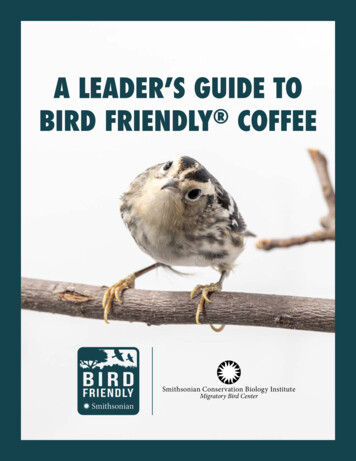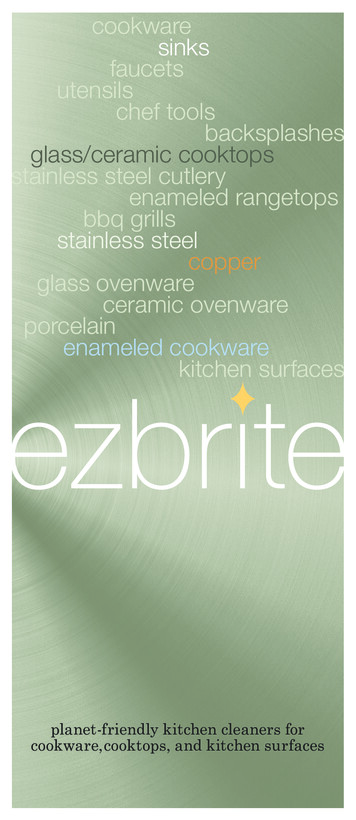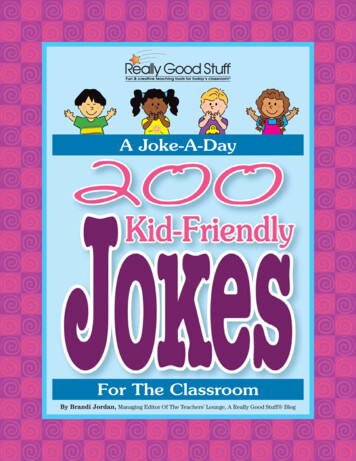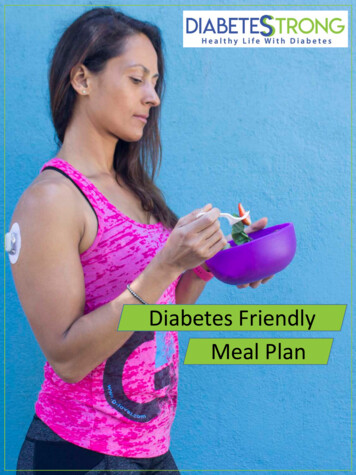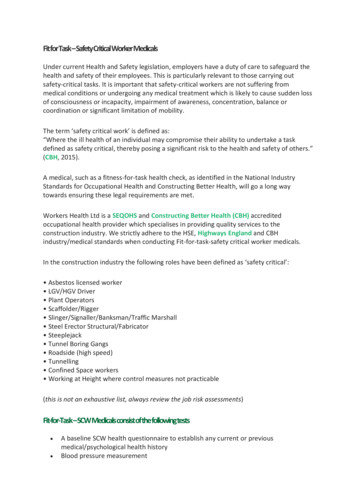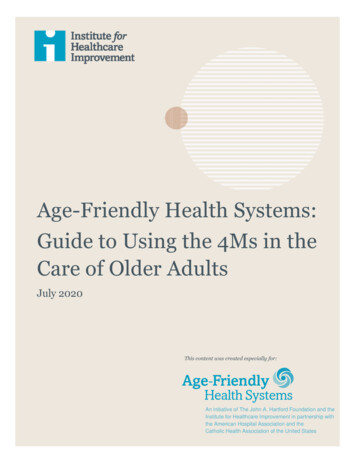
Transcription
Age-Friendly Health Systems:Guide to Using the 4Ms in theCare of Older AdultsJuly 2020This content was created especially for:An initiative of The John A. Hartford Foundation and theInstitute for Healthcare Improvement in partnership withthe American Hospital Association and theCatholic Health Association of the United States
Acknowledgments:This work was made possible by The John A. Hartford Foundation, a private, nonpartisan, national philanthropy dedicatedto improving the care of older adults. For more information, visit www.johnahartford.org.IHI would like to thank our partners, the American Hospital Association (AHA) and the Catholic Health Association of theUnited States (CHA), for their leadership and support of the Age-Friendly Health Systems initiative. Learn more atihi.org/AgeFriendly.Thank you to the five prototype health systems — Anne Arundel Medical System, Ascension, Kaiser Permanente,Providence St. Joseph, and Trinity — for stepping forward to learn what it takes to become an Age-Friendly Health System.IHI is thankful to the Age-Friendly Health Systems Faculty and Advisory Groups (see Appendix A). We extend our deepestgratitude to co-chairs Ann Hendrich, PhD, RN, and Mary Tinetti, MD; and to Nicole Brandt, PharmD, MBA, Donna Fick,PhD, RN, and Terry Fulmer, PhD, RN. We are grateful to Cayla Saret and Val Weber of IHI for their support in editing thisdocument. The authors assume full responsibility for any errors or misrepresentations. Thank you to the core team at IHIthat has worked on the Age-Friendly Heath Systems initiative — Kedar Mate, Leslie Pelton, Karen Baldoza, and KellyAnneJohnson Pepin — and all advisors, faculty and staff.For more than 25 years, the Institute for Healthcare Improvement (IHI) has used improvement science to advance and sustain better outcomes in healthand health systems across the world. We bring awareness of safety and quality to millions, accelerate learning and the systematic improvement of care,develop solutions to previously intractable challenges, and mobilize health systems, communities, regions, and nations to reduce harm and deaths. Wework in collaboration with the growing IHI community to spark bold, inventive ways to improve the health of individuals and populations. We generateoptimism, harvest fresh ideas, and support anyone, anywhere who wants to profoundly change health and health care for the better. Learn more atihi.org.Copyright 2020 Institute for Healthcare Improvement. All rights reserved. Individuals may photocopy these materials for educational, not-for-profit uses, provided that thecontents are not altered in any way and that proper attribution is given to IHI as the source of the content. These materials may not be reproduced for commercial, for-profituse in any form or by any means, or republished under any circumstances, without the written permission of the Institute for Healthcare Improvement.
ContentsAge-Friendly Health Systems Overview4Putting the 4Ms into Practice7Appendix A: Age-Friendly Health Systems Advisory Groups and Faculty19Appendix B: Process Walk-Through: Know the 4Ms in Your Health System20Appendix C: 4Ms Age-Friendly Care Description Worksheet22Appendix D: Key Actions and Getting Started with Age-Friendly Care29Appendix E: Age-Friendly Care Workflow Examples44Appendix F: Examples of PDSA Cycles for Age-Friendly Care48Appendix G: Implementing Reliable 4Ms Age-Friendly Care54Appendix H: Measuring the Impact of 4Ms Age-Friendly Care55References56Institute for Healthcare Improvement ihi.org 3
Age-Friendly Health Systems: Guide to Using the 4Ms in the Care of Older Adults (July 2020)Age-Friendly Health Systems OverviewThe United States is aging. The number of older adults, individuals ages 65 years and older, isgrowing rapidly. As we age, care often becomes more complex. Health systems are frequentlyunprepared for this complexity, and older adults suffer a disproportionate amount of harm whilein the care of the health system.To address these challenges, in 2017, The John A. Hartford Foundation (JAHF) and the Institutefor Healthcare Improvement (IHI), in partnership with the American Hospital Association (AHA)and the Catholic Health Association of the United States (CHA), set a bold vision to build a socialmovement so that all care with older adults is age-friendly care. According to our definition, agefriendly care: Follows an essential set of evidence-based practices; Causes no harm; and Aligns with What Matters to the older adult and their family or other caregivers.Becoming an Age-Friendly Health System entails reliably providing a set of four evidence-basedelements of high-quality care, known as the “4Ms,” to all older adults in your system. Whenimplemented together, the 4Ms represent a broad shift by health systems to focus on the needs ofolder adults (see Figure 1).The Age-Friendly Health Systems movement now comprises several hundred hospitals, practices,and post-acute long-term care (PALTC) communities working to reliably deliver evidence-basedcare for older adults. IHI and JAHF celebrate the participation of organizations that havecommitted to practicing age-friendly 4Ms care. Learn more about how you can join the movementand show your commitment to better care for older adults at ihi.org/AgeFriendly.Institute for Healthcare Improvement ihi.org 4
Age-Friendly Health Systems: Guide to Using the 4Ms in the Care of Older Adults (July 2020)Figure 1. 4Ms Framework of an Age-Friendly Health SystemThe 4Ms — What Matters, Medication, Mentation, and Mobility — make care of older adults,which can be complex, more manageable. The 4Ms identify the core issues that should drive alldecision making in the care of older adults. They organize care and focus on the older adult’swellness and strengths rather than solely on disease. The 4Ms are relevant regardless of an olderadult’s individual disease(s). They apply regardless of the number of functional problems an olderadult may have, or that person’s cultural, racial, ethnic, or religious background.1The 4Ms are a framework, not a program, to guide all care of older adults wherever and wheneverthey come into contact with your health system’s care and services. The intention is to incorporatethe 4Ms into existing care, rather than layering them on top, in order to organize the efficientdelivery of effective care. This integration is achieved primarily through redeploying existing healthsystem resources. Many health systems have found they already provide care aligned with one ormore of the 4Ms for many of their older adult patients. Much of the effort, then, involvesincorporating the other elements and organizing care so that all 4Ms guide every encounter withan older adult and their family or other caregivers.Institute for Healthcare Improvement ihi.org 5
Age-Friendly Health Systems: Guide to Using the 4Ms in the Care of Older Adults (July 2020)4Ms Framework: Not a Program, But a Shift in Care The 4Ms Framework is not a program, but a shift in how we provide care to olderadults. The 4Ms are implemented together (i.e., all 4Ms as a set of evidence-basedelements of high-quality care for older adults). Your system probably practices at least a few of the 4Ms in some places, at sometimes. Engage existing champions for each of the 4Ms, build on what you alreadydo, and spread it across your system. The 4Ms must be practiced reliably (i.e., for all older adults, in all settings andacross settings, in every interaction).There are two key drivers of age-friendly care: knowing about the 4Ms for each older adult in yourcare (“assess”), and incorporating the 4Ms into the plan of care accordingly (“act on”) (see Figure2). Both must be supported by documentation and communication across settings and disciplines.Figure 2. Two Key Drivers of Age-Friendly Health SystemsDeveloped with our expert faculty and advisors (see Appendix A) and five pioneering healthsystems — Anne Arundel Medical Center, Ascension, Kaiser Permanente, Providence, and TrinityHealth — this Guide to Using the 4Ms in the Care of Older Adults is designed to help care teamstest and implement a specific set of evidence-based, geriatric best practices that correspond to eachof the 4Ms. Though assessing and acting on the 4Ms is similar in most care settings, there are somedifferences. This Guide begins by outlining the 4Ms for hospital-based and ambulatory/primarycare-based settings.Institute for Healthcare Improvement ihi.org 6
Age-Friendly Health Systems: Guide to Using the 4Ms in the Care of Older Adults (July 2020)Putting the 4Ms into PracticeA “recipe” for integrating the 4Ms into your standard care has steps and ingredients, just like arecipe. These steps include:Understand your current stateDescribe care consistent with the 4MsDesign or adapt your workflowProvide careStudy your performanceImprove and sustain careWhile we present the six steps as a sequence, in practice you can approach steps 2 through 6 as aloop aligned with Plan-Do-Study-Act cycles (see Figure 3).Figure 3. Integrating the 4Ms into Care Using the PDSA CycleStep 1. Understand Your Current StateThe aim of an Age-Friendly Health System is to reliably apply the two key drivers of age-friendlycare: assess and act on the 4Ms with all older adults. Almost all systems integrate some of the 4Msinto care, some of the time, with some older adults, in some place in their system. With anunderstanding of your current experience and capacity to engage in 4Ms care, you can build onthat good work until the 4Ms are reliably practiced with all older adults.The following steps help you prepare for your journey to becoming an Age-Friendly Health Systemby understanding your current state – knowing the older adults and the status of the 4Ms in yourhealth system currently — and then selecting a care setting and establishing a team to begintesting.Institute for Healthcare Improvement ihi.org 7
Age-Friendly Health Systems: Guide to Using the 4Ms in the Care of Older Adults (July 2020)Know the Older Adults in Your Health SystemEstimate the number of adult patients you served in each age group in the last month (see Table 1).Table 1. Adult Patients Served in the Last Month (by Age Group)Age GroupNumberPercent of Total Patients18–64 years65–74 years75–84 years85 yearsTotal Number of AdultPatients100%For adult patients ages 65 and older in your care, specify their language, race/ethnicity, religiousand cultural preferences (see Table 2), and health literacy levels (see Table 3).Table 2. Language, Race/Ethnicity, and Religious and Cultural Preferences ofPatients 65 Years and OlderLanguage:Percent of Total Patients Ages 65 Race/Ethnicity:Percent of Total Patients Ages 65 Religious and Cultural Preferences:Percent of Total Patients Ages 65 Table 3. Health Literacy Levels of Patients 65 Years and OlderHealth Literacy LevelPercent of Total Patients Ages 65 LowModerateHighInstitute for Healthcare Improvement ihi.org 8
Age-Friendly Health Systems: Guide to Using the 4Ms in the Care of Older Adults (July 2020)Know the 4Ms in Your Health SystemTo identify where the 4Ms are in practice in your health system, walk through activities as if youwere an older adult or family member or other caregiver. In an ambulatory setting, that mayinclude making an appointment for an Annual Wellness Visit, preparing to come to an AnnualWellness Visit, observing an appointment, and understanding who on the care team takesresponsibility for each of the 4Ms. In an inpatient setting, go through registration, spend time on aunit, and sit quietly in the hall of a unit. Look for the 4Ms in action. You will find aspects that makeyou proud and others that leave you disappointed. Try not to be judgmental. Find bright spots,opportunities, and champions of each of the 4Ms in your system.Use the form provided in Appendix B to note what you learn.Select a Care Setting to Begin TestingOnce you know about your older adults and identify where the 4Ms currently exist in your healthsystem, select a care setting in which to begin testing age-friendly interventions. Some questions toconsider when selecting a site: Is there a setting where a larger number of older adults regularly receives care? Is there will at this setting to become age-friendly and improve care for older adults? Is therea champion? Is this setting relatively stable (i.e., not undergoing major changes already)? Does this setting have access to data? (See the “Study Your Performance” section below formore on measurement. Data is useful, though not required.) Can this setting be a model for the rest of the organization? (Modeling is not necessary, butuseful to scale-up efforts.) Is there a setting where your team members have experience with the 4Ms either individuallyor in combination? Do they already have some processes, tools, and/or resources to supportthe 4Ms? Is there a setting where the health literacy levels, language skills, and cultural preferences ofyour patients match the assets of the staff and the resources provided by your health system?Set Up a TeamBased on our experience, teams that include certain roles and/or functions are most likely tosucceed (see Table 4).Institute for Healthcare Improvement ihi.org 9
Age-Friendly Health Systems: Guide to Using the 4Ms in the Care of Older Adults (July 2020)Table 4. Team Member RolesTeam MemberDescriptionAn Older Adultand CaregiverPatients and families or other caregivers bring critical expertise to anyimprovement team. They have a different experience with the system thanproviders and can identify key issues. We highly recommend that eachteam has at least one older adult, family member, or other caregiver(ideally more than one), or a way to elicit feedback directly from theseindividuals (e.g., through a Patient and Family Advisory Council).Additional information about appropriately engaging patients and familiesin improvement efforts can be found on the Valuing Lived Experience:Why Science Is Not Enough and Institute for Patient- and Family-CenteredCare website.Leader/SponsorThis person champions, authorizes, and supports team activities, as wellas engages senior leaders and other groups within the organization toremove barriers and support implementation and scale-up efforts.Although they may not do the “on-the-ground” work, the leader/sponsor isresponsible for: Building a case for change that is based on strategic priorities and thecalculated return on investment; Encouraging the improvement team to set goals at an appropriate level; Providing the team with needed resources, including staff time andoperating funds; Ensuring that improvement capability and other technical resources,especially those related to information technology (IT) and electronichealth records (EHR), are available to the team; and Developing a plan to scale up successful changes from theimprovement team to the rest of the organization.AdministrativePartnerThis person represents the disciplines involved in the 4Ms and workseffectively with the clinicians, other technical experts, and leaders withinthe organization. We recommend placing the manager of the unit wherechanges are being tested in this role because that individual can likelymove nimbly to take necessary action and make the recommendedchanges in that unit and is invested in sustaining changes that result inimprovement.Clinicians whoRepresent theDisciplinesInvolved in the4MsThese individuals may include a physician, nurse, physical therapist,social worker, pharmacist, chaplain, and/or others who represent the 4Msin your context. We strongly encourage interprofessional representation onyour team and urge you to enlist more than one clinical champion.Others Improvement coach Data analyst/EHR analyst Finance representativeThese champions should have good working relationships with colleaguesand be interested in driving change to achieve an Age-Friendly HealthSystem. Consider professionals who are opinion leaders in theorganization, who are sought by others for advice, and who are not afraidto test and implement change.Institute for Healthcare Improvement ihi.org 10
Age-Friendly Health Systems: Guide to Using the 4Ms in the Care of Older Adults (July 2020)Step 2. Describe Care Consistent with the 4MsThere are many ways to improve care for older adults. However, there is a finite set of key actions,summarized below, that touch on all 4Ms and dramatically improve care when implementedtogether (see Table 5). This list of actions is considered the gateway to your journey to becoming anAge-Friendly Health System. In Appendix D you will find a list of these key actions and ways to getstarted with each one in your setting, as well as additional tips and resources. Be sure to plan howyou will document and make visible the 4Ms across the care team and settings.Using the 4Ms Care Description Worksheet provided in Appendix C, describe a plan for how yoursystem will provide care consistent with the 4Ms. This worksheet helps you to assess, document,and act on the 4Ms as a set, while customizing the approach to practicing the 4Ms for your context.To be considered an Age-Friendly Health System, your system must engage or assess people ages65 and older for all 4Ms, document 4Ms information, and act on the 4Ms accordingly. As you testthe 4Ms, you may make updates to your Description based on what you learn about the tools andmethods that work best in your context.Questions to consider: How does your current state compare to the actions outlined in the 4Ms Care DescriptionWorksheet? Which of the 4Ms do you already incorporate? How reliably are they practiced? For example: Do you already ask and document What Matters, review for high-riskmedication use, screen for delirium, dementia, and depression, and screen for mobilityfor each older adult?Where are there gaps in 4Ms? What ideas do you have to fill the gaps? Some ideas for how toget started filling those gaps are provided in Appendix D.In this step, describe the initial plan for 4Ms care for the older adults you serve.Set an AimGiven your current state, set an aim for this initial effort. An aim articulates what you are trying toaccomplish — what, how much, by when, for whom. It serves as the focus for your team’s work andenables you to measure your progress. Below is an aim statement template that requires you tothink about the reach of 4Ms. We suggest starting with what you want to accomplish in the next sixmonths.Aim Statement TemplateBy [DATE], [NAME OF ORGANIZATION] will articulate how it operationalizes 4Ms careand will have provided that 4Ms care in [NUMBER] of encounters with patients 65 yearsold.Institute for Healthcare Improvement ihi.org 11
Age-Friendly Health Systems: Guide to Using the 4Ms in the Care of Older Adults (July 2020)Step 3. Design or Adapt Your WorkflowMany ideas you may have in place already. You can maintain, improve, and expand them wherenecessary. Other ideas you may still need to test and implement. The key is to ensure that thesepractices are reliable — happening every time in every setting for every older adult you serve (andtheir caregives).Table 5. Age-Friendly Health Systems Summary of Key ActionsHospitalAssessAct OnKnow about the 4Ms for eacholder adult in your careIncorporate the 4Ms intothe plan of careKey Actions (to occur at least daily): Ask the older adult What Matters Document What Matters Review for high-risk medicationuse Screen for delirium at least every12 hours Screen for mobility limitations Align the care plan with WhatMatters Deprescribe and dose-adjust highrisk medications and avoid theiruse whenever possible Ensure sufficient oral hydration Orient older adults to time, place,and situation Ensure that older adults have theirpersonal adaptive equipment Prevent sleep interruptions; usenonpharmacological interventionsto support sleep Ensure early, frequent, and safemobilityAmbulatory Key Actions (to occur at least annually or after change in condition): Ask the older adult What Matters Document What Matters Review for high-risk medicationuse Screen for cognitive impairment Screen for depression Screen for mobility limitations Align the care plan with WhatMatters Deprescribe and dose-adjust highrisk medications, and avoid theiruse whenever possible If cognitive impairment screen ispositive, refer for further evaluationand manage manifestations ofcognitive impairment If depression screen is positive,identify and manage factorscontributing to depression andinitiate, or refer out, for treatment Ensure safe mobilityInstitute for Healthcare Improvement ihi.org 12
Age-Friendly Health Systems: Guide to Using the 4Ms in the Care of Older Adults (July 2020)Supporting Actions: Use the 4Ms to organize care and focus on the older adult, wellness, and strengths rather thansolely on disease or lack of functionality. Integrate the 4Ms into care or existing workflows. Identify which activities you can stop doing to reallocate resources to reliably practice the4Ms. Document all 4Ms and consider grouping the 4Ms together in the medical record. Make the 4Ms visible across the care team and settings. Form an interdisciplinary care team that reviews the 4Ms in daily huddles and/or rounds. Educate older adults, caregivers, and the community about the 4Ms. Link the 4Ms to community resources and supports to achieve improved health outcomes.Overall, look for opportunities to combine or redesign activities, processes, and workflows aroundthe 4Ms. In this effort you may find that you can stop certain activities and reallocate resources tosupport age-friendly care.If you have process flow diagrams or value-stream maps of your daily care, edit these views of yourworkflow to include the key actions above and your description of age-friendly care.You may start with a high-level workflow like the examples shown below (see Figures 4 and 5).Figure 4. Age-Friendly Care Workflow Example for Hospitals: Core FunctionsFigure 5. Age-Friendly Care Workflow Example for Primary Care:Core Functions for New Patient, Annual Visit, or Change in Health StatusThen work through the details in the space below each high-level block to show how you willincorporate the 4Ms. Be specific about who will do what, where, when, how, and how it will bedocumented. Examples are included in Appendix E.Outline what you still need to learn and identify what you will test (e.g., using the Timed Up & GoTest to evaluate mobility and fall risk).Institute for Healthcare Improvement ihi.org 13
Age-Friendly Health Systems: Guide to Using the 4Ms in the Care of Older Adults (July 2020)Step 4. Provide CareLearn as you move toward reliable 4Ms care. Begin to test the key actions with one older adult andtheir family or other caregivers as soon as you have notes for step 2, Describe Care Consistent withthe 4Ms, and step 3, Design or Adapt Your Workflow. Do not wait to have your forms or EHRscreens finalized before you test with one older adult. Use the Plan-Do-Study-Act tool to learnmore from your tests. Then, scale up your tests. For example: Apply your draft standard procedure and workflow first with one patient. Can your teamfollow the procedure in your work environment? If necessary, modify your procedure. Then, apply it with five patients. What lessons do youlearn from applying 4Ms care with these patients? What impact does learning about all 4Mshave on care plans? If necessary, modify your procedure. Then, apply with 25 patients and keep going. Are yougetting close to being able to use your procedure for every patient? Are you getting goodresults? Examples of PDSA cycles can be found in Appendix F.Step 5. Study Your PerformanceHow reliable is your 4Ms care? What impact does your 4Ms care have? Here is an approach tostudy your performance.Observe and Seek to UnderstandObserve: Start your study with direct observation of your draft 4Ms Care Description in action. Can your team follow the Care Description and successfully assess and act on the 4Ms withthe older adults in your care? Do your care plans reflect 4Ms care?In the first month, do this for at least one patient each week. Then, for the next six months, observe4Ms care for at least five patients each month.Ask Your Team: At least once per month for the seven months of your efforts, ask your team twoopen-ended questions and reflect on the answers: What are we doing well to assess and act on the 4Ms? What do we need to change to translate the 4Ms into more effective care?Plan with your team how and when you will continue to reflect together using open-endedquestions on an ongoing basis.Ask Older Adults and Caregivers: At least once in the first month of your effort, ask an olderadult and family or other caregiver two open-ended questions and reflect on the answers: What went well in your care today? What could we do better to understand what age-friendly care means to you?Institute for Healthcare Improvement ihi.org 14
Age-Friendly Health Systems: Guide to Using the 4Ms in the Care of Older Adults (July 2020)Then try the questions with five additional older adults in the second month. Plan with your teamhow and when you will continue to talk with older adults using open-ended questions on anongoing basis. Consider engaging an older adult as a member of the team that is working to adoptthe 4Ms.Measure How Many Patients Receive 4Ms CareThere are three options to start measuring the number of patient encounters that include 4Mscare. We recommend Option 1 because it forces close attention to the 4Ms work and takes lesseffort than conducting retrospective chart audits or building a specific EHR report.Option 1: Real-Time ObservationUse real-time observation and staff reporting of the work to tally your 4Ms counts on a whiteboardor paper. An example for patients seen in the primary care clinic might look like the chart below(see Figure 6).Figure 6. Example of Real-Time Observation in a Primary Care ClinicOption 2: Chart ReviewUsing a tally sheet like the example discussed in Option 1, review charts for evidence of 4Ms care.At the start of your work using the 4Ms, review charts of patients with whom you have tested 4Mscare (M) to confirm proper documentation. To estimate the number of patient encounters thatinclude 4Ms care in a particular time period (e.g., monthly), randomly sample 20 charts frompatients who received care during that time (out of M). Observe out of the 20 how many receivedyour described care (C).Institute for Healthcare Improvement ihi.org 15
Age-Friendly Health Systems: Guide to Using the 4Ms in the Care of Older Adults (July 2020)Calculate the approximate number of patient encounters that include 4Ms care in the time periodas follows:Estimated number of patient encounters including 4Ms care (M x C) divided by 20Option 3: EHR ReportYou may be able to run EHR reports, especially on assessment of the 4Ms, to estimate the numberof patient encounters that include 4Ms care in a particular time period. It may take a lot of effort tocreate a suitable report, so we do not recommend this option as your first choice. However, forongoing process control, some organizations may wish to develop reports that show 4Msperformance; you can request report development from your IT service while starting with Option1 or 2.Routine Counting of PatientsOnce your site provides 4Ms care with high reliability (see Appendix G), then the estimate of thenumber of patient encounters that include 4Ms care is simple: Report the volume of patientsreceiving care from your site during the measurement period.Additional Measurement Guidance and RecommendationsThe tables below provide additional guidance for counting the number of patients receiving agefriendly (4Ms) care.Hospital Site of CareMeasure NameNumber of Patients Who Receive Age-Friendly (4Ms) CareMeasure DescriptionNumber of patients 65 who receive 4Ms care as described by the hospitalSiteHospitalPopulation MeasuredAdult patients 65 Measurement PeriodMonthlyCountInclusion: Patients 65 with LOS 1 day present on the unit between 12:01 AMon the first day of the measurement period and 11:59 PM on the last day of themeasurement period who receive the unit’s description of 4Ms careInstitute for Healthcare Improvement ihi.org 16
Age-Friendly Health Systems: Guide to Using the 4Ms in the Care of Older Adults (July 2020)Measure Notes The measure may be applied to units within a system as well as the entiresystem. See the 4Ms Care Description Worksheet to describe 4Ms care foryour unit. To be considered age-friendly (4Ms) care, you must engage orscreen all patients 65 for all 4Ms, document the results, and act on them asappropriate. If a total count is not possible, you can sample (e.g., audit 20 patient charts)and estimate the total number of patient encounters using 4Ms care/20 x totalnumber of patients cared for in the measurement period. If you are sampling,please note that when sharing data. Once you have established 4Ms care as the standard of care on your unit,validated by regular observation and process review, you can estimate thenumber of patients receiving 4Ms care as the number of patients cared for bythe unit. You do not need to filter the number of patients by unique medical recordnumber (MRN).Ambulatory/Primary Care Site of CareMeasure NameNumber of Patients Who Receive Age-Friendly (4Ms) CareMeasure DescriptionNumber of patients 65 who receive 4Ms care as described by the measuringunitSiteAmbulatoryPopulation MeasuredAdult patients 65 Measurement PeriodMonthlyCountInclusion: All patients 65 in the population considered to be patients of theambulatory or primary care practice (e.g., patient assigned to a care team paneland seen by the practice within the past three years) who have an office visit,home visit, or tele-medicine visit with the practice during the measurement periodand who receive 4Ms care as described by the site.Exclusions: NoneMea
Appendix B: Process Walk-Through: Know the 4Ms in Your Health System 20 Appendix C: 4Ms Age-Friendly Care Description Worksheet 22 Appendix D: Key Actions and Getting Started with Age-Friendly Care 29 Appendix E: Age-Friendly Care Workflow Examples 44 Appendix F: Examples of PDSA Cycles for Age-Friendly Care 48
